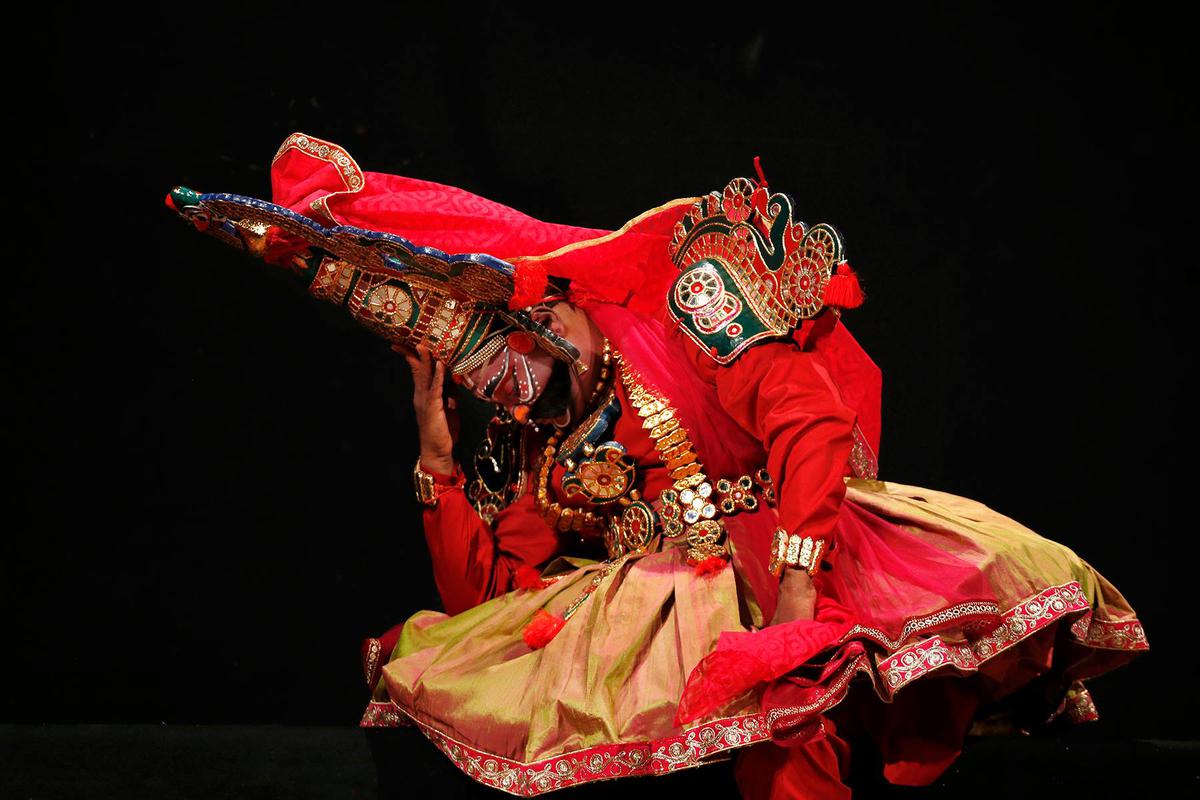Rajagopal with junior students of the gurukulam
| Photo Credit: AKSHAYA RA0
“The effort should not show. Sing with a smiling face,” says P. Rajagopal. The man, known for his raging Dushasana vesham, and a voice that carries the still night air around the villages of Kanchipuram, sings a song of unfulfilled desire.
I sit transfixed watching the 71-year-old actor-singer deliver a nuanced demonstration of Sringara bhava. I am at Kattaikkuttu Sangam to train in the form. Our classes take place in the indoor theatre of the Sangam’s sprawling green campus in Punjarasantankal village in Kanchipuram.
Art is labour, according to Rajagopal, who took over the Perunkattur troupe from his father, Ponnucami Vattiyar at the age of 19, when the senior artiste passed away. A typical Koothu goes on for eight hours. The actor must build stamina and will to perform in a heavy attire with wooden ornaments on shoulders and the crown. Rajagopal has even put health at stake for the love of the art form. A fall from a bench while enacting the role of Keechakan as part of a 18-day long Mahabharata koothu in the late 1970s at Avalur Village left him with a permanent knee injury.
One of Rajagopal’s most memorable roles is the Dushasana vesham he performed did in the 1970s. “Before the performance, there was another group waiting to get the thamboolam (contract) from the village heads. If we were not performing well, the villagers had every right to call us off stage and ask our competitors to take over.” But, a few minutes into the performance by Rajagopal and his uncle, the crowd knew the other team did not stand a chance! He divulges the secret of his craft to me: making variations in the rhythm while dancing adavus. “That keeps the audience entertained,” says the veteran.
Hanne and Rajagopal started Kattaikkuttu Sangam in 1990
Rajagopal and his wife Hanne M. de Bruin, an independent researcher from Amsterdam, co-founded the Kattaikkuttu Sangam in 1990. Restoring the dignity of this art form, shunned by the mainstream classical arts world as ‘folk’, has been their main mission. “Hence, we started a gurukulam in 2002. I wanted to keep Koothu’s intrinsic quality alive, the way I was taught by my father,” recalls Rajagopal.
The gurukulam, which they had to close down during the pandemic due to financial reasons, has moulded a new generation of Kattaikkuttu performers, who are also trained in classical music, acrobatics and clowning by the country’s finest artistes and international theatre practitioners. When I travelled with the present company to different villages to perform in all-night koothu, I could sense the rigorous training they have gone through. It is evident in the precision of of their steps and emotional dexterity. “When people see my students perform, they tell me they are reminded of me. I have taught them exactly the way I have learnt. There has been no dilution,” says Rajagopal.

An actor playing Duryodhana
Rajagopal and Hanne’s interventions have also encouraged young rural women artistes to perform a form that was once male-dominated. “It was a challenge for me to prove to my parents I am as capable as a boy. Today there isn’t a thing I can’t do,” says Venda, a student.
Expanding the repertoire has been another contribution of Rajagopal to Kattaikkuttu. It was during a bus journey from Puducherry to Kanchipuram when the idea to write new stories dawned on him. “Myself and Hanne met a programme officer to book a show. The lady asked me, ‘Apart from gods and mythologies, do your plays address social issues?’ That got me thinking. On the way back home, a story of talking trees emerged. That’s exactly when from an actor I also became a writer.” And soon followed other plays such as Magic Horse on aliens, Milky Ocean about a dystopian world, War Games on Pandavas and Kauravas and RamaRavana, a critical take on the Ramayana and so on.
Rajagopal as Karna in ‘Karna Moksham’
Steeped in their performance tradition, the Sangam, however, has never been insular, thanks to the innate openness of its founders. Rajagopal and Hanne have always been welcoming of new ideas. In their annual festivals, they have hosted performances such as Kathakali and Koodiyattam, and contemporary plays.
Rajagopal says they plan to make this space into one where multiple art forms converge. During my last few days of training, I realised how Rajagopal or thaatha as he is endearingly called by his students has offered me lessons on finer aspects of Koothu, which I will carry through my life as an actor. He says most troupes are hesitant to share their knowledge with outsiders. “If you are ready to learn, I am ready to teach you,” he says with a smile.
Parshathy Nath is the Project Coordinator of the Foundation Project implemented by India Foundation for the Arts (IFA) under the Arts Practice programme, made possible with support from Sony Pictures Entertainment Fund.